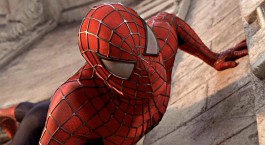 Spider-Man appears in an aspect ratio of approximately 1.85:1 on this single-sided, dual-layered DVD; the image has been enhanced for 16X9 televisions. Although the picture remained pretty positive as a whole, it showed a few more concerns than I expected from a recent, big-budget blockbuster.
Spider-Man appears in an aspect ratio of approximately 1.85:1 on this single-sided, dual-layered DVD; the image has been enhanced for 16X9 televisions. Although the picture remained pretty positive as a whole, it showed a few more concerns than I expected from a recent, big-budget blockbuster.
Sharpness usually seemed fine, though the image looked a little less detailed than I’d like. It remained reasonably crisp most of the time, but occasionally some shots looked slightly soft. Nonetheless, most of the movie appeared solid. Jagged edges and moiré effects created no concerns, but I noticed some minor edge enhancement at times. As for print flaws, light grain appeared periodically during the movie, and I also observed a few too many examples of speckles.
Given the comic book setting, I expected a varied palette, and Spider-Man didn’t disappoint. The image presented nicely bright and vivid colors that consistently appeared rich and vibrant. Black levels generally came across as deep and dense, though they occasionally looked somewhat inky. Shadow detail presented some concerns, as low-light situations seemed a little too dark much of the time. This made those scenes a bit murky and tough to discern. Overall, Spider-Man looked okay, but I didn’t think the image seemed much better than average given the age and budget of the material.
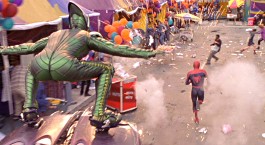 On the other hand, the Dolby Digital 5.1 soundtrack of Spider-Man offered a consistently solid presentation. The soundfield made good use of all five channels and created a nicely involving environment. Music presented clean stereo imaging, while effects cropped up from all around the spectrum. Though not the most active track in the world, it used the different speakers well as a whole. Much of the material remained atmospheric, and the mix did a nice job with small touches such as cars and voices like the yelling from MJ’s father. The action scenes kicked it up a notch, of course, and they provided a lively and engrossing set. The Goblin’s flyer offered some of the best moments, as it zoomed nicely across both the front and the rear.
On the other hand, the Dolby Digital 5.1 soundtrack of Spider-Man offered a consistently solid presentation. The soundfield made good use of all five channels and created a nicely involving environment. Music presented clean stereo imaging, while effects cropped up from all around the spectrum. Though not the most active track in the world, it used the different speakers well as a whole. Much of the material remained atmospheric, and the mix did a nice job with small touches such as cars and voices like the yelling from MJ’s father. The action scenes kicked it up a notch, of course, and they provided a lively and engrossing set. The Goblin’s flyer offered some of the best moments, as it zoomed nicely across both the front and the rear.
Audio quality appeared very good. Speech seemed warm and natural, and I noticed no issues related to edginess or intelligibility. The score sounded nicely robust and dynamic, as the music showed clean highs and rich lows. Effects also came across as vibrant and distinctive. They lacked any signs of distortion and seemed vivid and rich. The track boasted nice bass response, as low-end material packed a nice punch. The audio for Spider-Man didn’t stand out as one of the best soundtracks ever, but it nicely complemented the material.
For the special edition release of Spider-Man, we encounter scads of extras across this two disc set. On DVD One, we start with two separate audio commentaries. Entitled “Filmmakers and Cast”, the first features director Sam Raimi, actor Kirsten Dunst, producer Laura Ziskin, and co-producer Grant Curtis. Unusually, the track presents two sets of pairs. Ziskin and Dunst sat together for their screen-specific piece, while Raimi and Curtis also were recorded together as they watched the flick. The commentary’s producers then combined the two for this one edited track. To their credit, they didn’t take the annoying approach found on pieces like Beauty and the Beast where they tried desperately to make it sound like all the participants sat together. The Spider-Man commentary doesn’t highlight the fact the pairs were apart, but it also doesn’t use any tricks to convince us otherwise.
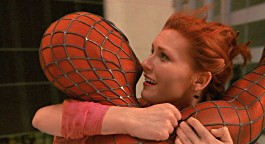 I’d guess that the DVD’s producers originally intended to provide the two halves of this commentary on their own but combined them because the speakers offered so little content. Even with this package approach, the track still suffers from lots of gaps, as plenty of the movie passes without any information. When we do hear from the participants, they fail to offer much useful material. Occasionally some good tidbits appear, and Ziskin provides the commentary’s best moments as she fills us in on different behind the scenes notes such as how they made pre-transformation Peter Parker look scrawny. Dunst says little about her work but she tosses in some funny gripes about the movie that provide an amusing point of view.
I’d guess that the DVD’s producers originally intended to provide the two halves of this commentary on their own but combined them because the speakers offered so little content. Even with this package approach, the track still suffers from lots of gaps, as plenty of the movie passes without any information. When we do hear from the participants, they fail to offer much useful material. Occasionally some good tidbits appear, and Ziskin provides the commentary’s best moments as she fills us in on different behind the scenes notes such as how they made pre-transformation Peter Parker look scrawny. Dunst says little about her work but she tosses in some funny gripes about the movie that provide an amusing point of view.
As for the men, they mainly just praise different aspects of the production. Raimi occasionally offers some decent notes, and he also cracks wise from time to time; in particular, he gives us a humorous quip about Tobey Maguire’s motivation for a crying scene. Curtis offers little of consequence, however. Overall, this commentary seems listenable and modestly entertaining, but it doesn’t provide much information about the movie and it seems like a moderate disappointment.
Called “Visual Effects Designer and Crew”, the second commentary includes remarks from visual effects designer John Dykstra, visual effects supervisor Scott Stokdyk and director of animation Anthony LaMolinara. All three men sat together for this running, screen-specific track. Not surprisingly, this piece sticks mainly with technical issues, but after a slow start, it manages to provide a reasonably informative and entertaining experience. Some gaps appear early in the program, but it soon picks up the pace and the three fill most of the time. They go over a mix of effects related topics, with a particular emphasis on the computer material. They help give us a nice look at all of these subjects and offer one of the better discussions of effects that I’ve heard.
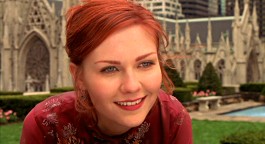 If you activate the Spider-Sense option, a Spidey icon will appear periodically during the movie. Hit “enter” when this occurs and you can check out a variety of “web-i-sodes”. These pop up sporadically during the movie and provide short featurettes about a mix of topics. Among other subjects, we learn about model making, spider wrangling, and production design. The featurettes run between 100 seconds and eight minutes, 45 seconds. None of them seem particularly memorable, but they help add a little depth to our knowledge of the film’s creation.
If you activate the Spider-Sense option, a Spidey icon will appear periodically during the movie. Hit “enter” when this occurs and you can check out a variety of “web-i-sodes”. These pop up sporadically during the movie and provide short featurettes about a mix of topics. Among other subjects, we learn about model making, spider wrangling, and production design. The featurettes run between 100 seconds and eight minutes, 45 seconds. None of them seem particularly memorable, but they help add a little depth to our knowledge of the film’s creation.
For another feature that appears as you watch the film, we find Weaving the Web. This displays a very cool text commentary that covers a myriad of different topics. We learn about the film’s casting, the actors and other filmmakers, various “nuts and bolts” challenges like visual effects and costumes, and lots of fun information about the comics. Many general Spidey facts appear, and we also get some useful notes about how the movie takes liberty with the source material. Overall, this text piece offers a fine way to supplement your knowledge of the flick.
Also on DVD One, we get a section called the Marketing Campaign. This starts with a collection of trailers for Spider-Man, XXX, Men In Black II, Mr. Deeds, Stuart Little 2 and Stan Lee’s Mutants, Monsters and Marvels. Alas, the withdrawn Spider-Man teaser that prominently featured the World Trade Center towers doesn’t appear, unless it exists as an Easter egg. We then find a whopping 11 TV Spots.
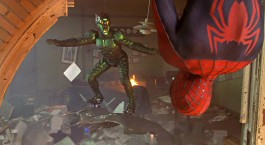 Also in “Marketing Campaign” we get two music videos. “Hero” by Chad Kroeger and featuring Josey Scott stages a lip-synched performance on a rooftop and intercuts shots from the movie; both the song and the video seem bland and boring. “What We’re All About (The Original Version” by Sum 41 features the same format, but at least it looks a little more interesting visually since the band members use their spider-powers to cling to walls while they perform. As for the song, it sounds like cut-rate Beastie Boys.
Also in “Marketing Campaign” we get two music videos. “Hero” by Chad Kroeger and featuring Josey Scott stages a lip-synched performance on a rooftop and intercuts shots from the movie; both the song and the video seem bland and boring. “What We’re All About (The Original Version” by Sum 41 features the same format, but at least it looks a little more interesting visually since the band members use their spider-powers to cling to walls while they perform. As for the song, it sounds like cut-rate Beastie Boys.
Character Files has nothing to do with the movie’s roles. Instead, it simply collects the usual simple filmographies for actors Tobey Maguire, Kirsten Dunst, Willem Dafoe, J.K. Simmons, Rosemary Harris, and Cliff Robertson. However, the disc’s DVD-ROM domain offers some departures from the norm. Most intriguing is “Record Your Own Commentary”. This allows you to add your own statements for the flick. Since I don’t have a microphone for my computer, I couldn’t participate myself. The DVD promises “bonus commentaries” that will appear online, but as I write this four days prior to the disc’s release, the site offers nothing along those lines.
Next we get the “Comic/Feature Comparison”. This extremely cool addition lets you do exactly what it says. Ala the standard script to screen feature, it shows the movie on the left and the comic book adaptation on the right. This allows you to examine both and it makes for a very fun piece.
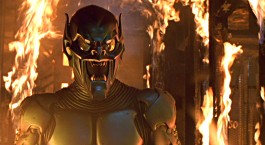 Lastly, disc one’s DVD-ROM area on disc one offers some weblinks. It connects you to Columbia-Tristar Home Entertainment and Sony Pictures Entertainment as well as a “Countdown to Spider-Man 2”. That Internet page doesn’t offer much right now, but it promises a mix of online events.
Lastly, disc one’s DVD-ROM area on disc one offers some weblinks. It connects you to Columbia-Tristar Home Entertainment and Sony Pictures Entertainment as well as a “Countdown to Spider-Man 2”. That Internet page doesn’t offer much right now, but it promises a mix of online events.
With that we bid adieu to the first disc and move to DVD Two, where we encounter lots more extras. These split into two different areas: Web of Spider-Man deals mainly with the comics, while The Goblin’s Lair offers information about the film. Within “Web”, we find another subsection entitled “The Evolution of Spider-Man”, and it includes a number of different components. Spider-Man: The Mythology of the 21st Century lasts 25 minutes and 26 seconds and covers topics related to the comics. Mostly it features comments from Spider-Man co-creator Stan Lee, Spider-Man artists John Romita Sr., Todd McFarlane, Erik Larsen, John Byrne, John Romita Jr., and Tim Gale, writer Jeph Loeb, Marvel Comics editor-in-chief Joe Quesada, Marvel Comics president Bill Jemas, Wizard Magazine editor Brian Cunningham, filmmaker Kevin Smith, editor Axel Alonzo, artist Steven Platt, and Wizard Magazine publisher Gareb Shamus.
While “Mythology” doesn’t offer a great general Spidey history, it gives us a decent look at the creative side behind the comics. We hear some about the character’s origins and development, and we learn of variations that occurred over the years, both in the visual and personality domains. The best aspects come from the artists’ discussions about their approaches to the character. Overall, “Mythology” doesn’t provide much special content, but it presents a reasonably informative and entertaining piece.
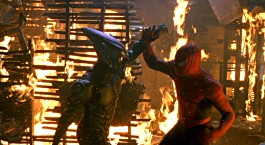 In the Spider-Man Archives, we discover a Spidey chronology broken down by decades. These then go over important Spidey developments in a year-by-year manner. It’s not the most user-friendly feature, but it includes a decent piece of coverage, even though it skips some major issues.
In the Spider-Man Archives, we discover a Spidey chronology broken down by decades. These then go over important Spidey developments in a year-by-year manner. It’s not the most user-friendly feature, but it includes a decent piece of coverage, even though it skips some major issues.
The Artists Gallery breaks down into four smaller domains of stillframe materials. “Environments” shows 30 pieces of concept art for the movie’s settings, while “Spider-Man” offers 13 drawings related to the film’s web-swinger design. “Green Goblin” gives us 18 screens of the same kind of art for the villain. Lastly, “Comic Book Artist Gallery” includes 19 drawings from various sources.
Within the Rogues Gallery we find nice little biographies for 14 prime Spidey villains. The Loves of Peter Parker does the same for the comic series’ four main female protagonists.
The final element of the “Web” area offers Activision Game Hints and Tips for its first three levels. If you own that piece of software, this section might prove useful. I don’t, so it isn’t.
Now we move to “The Goblin’s Lair”, where we discover materials related to the movie. The HBO “Making of” program Behind the Ultimate Spin offers a general look at the film. The 24-minute and 40-second piece combines lots of movie clips plus behind the scenes shots and interviews with director Sam Raimi, actors Tobey Maguire, Kirsten Dunst, Willem Dafoe, James Franco, Rosemary Harris, and Cliff Robertson, executive producer Avi Arad, co-creator Stan Lee, producers Laura Ziskin and Ian Bryce, director of photography Don Burgess, production designer Neil Spisak, and visual effects designer John Dykstra,
 If you’ve seen any others of these cable documentaries, you’ll know what to expect from “Spin”. It covers a mix of topics, from the origins of the comic book to the cast, production design, and effects. Unfortunately, it does so in a rather superficial manner. Although some of the material from the set seems interesting, those snippets fly by quickly, which means that movie segments and interviews dominate. The latter offer little concrete info and mostly just tell us how great everything is.
If you’ve seen any others of these cable documentaries, you’ll know what to expect from “Spin”. It covers a mix of topics, from the origins of the comic book to the cast, production design, and effects. Unfortunately, it does so in a rather superficial manner. Although some of the material from the set seems interesting, those snippets fly by quickly, which means that movie segments and interviews dominate. The latter offer little concrete info and mostly just tell us how great everything is.
For more of the same, check out an E! Entertainment special called Spider-Mania. During this 40-minute and 28-second program, we get the standard mix of movie clips, shots from the set, and interviews. We hear from director Raimi, co-creator Stan Lee, actors Dunst, Maguire, Dafoe, and Franco, comic book artist John Romita Jr., executive producer Avi Arad, producer Laura Ziskin, entomologist Steven Kutcher, and assorted Spidey fans. Much of “Spider-Mania” resembles “Spin”, though it places a somewhat greater emphasis on the interviews. These add a little more depth to the program, but it still remains superficial and promotional in nature. The most compelling part focuses on Kutcher and his spider wrangling. “Spider-Mania” offers a moderately entertaining piece but it doesn’t provide a very good look at the movie.
Next we get something called Director Profile: Sam Raimi. This seven-minute and three-second program offers some comments about the director. It shows a few shots from the set as well as movie clips and interviews with Raimi, Maguire, Dafoe, Dunst, Harris, Ziskin, Arad, actor Bruce Campbell, composer Danny Elfman, Stan Lee, and visual effects designer John Dykstra. We see some funny bits from the set where Raimi threatens people, but otherwise we mostly get more of the usual praise. A few of the same stories appear and the featurette seems moderately useful as best.
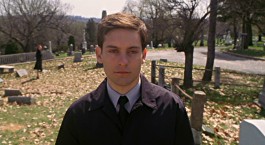 A similar but more compelling feature pops up next with Composer Profile: Danny Elfman. The seven-minute and 25-second piece includes comments from Raimi, Maguire, and Elfman. Unlike the superficial “Raimi” piece, this one provides a decent discussion of Elfman’s approach to composing and he also talks about the different themes he wrote. A composer commentary would have been preferable, but this short program gives us a quick and interesting view of Elfman’s work.
A similar but more compelling feature pops up next with Composer Profile: Danny Elfman. The seven-minute and 25-second piece includes comments from Raimi, Maguire, and Elfman. Unlike the superficial “Raimi” piece, this one provides a decent discussion of Elfman’s approach to composing and he also talks about the different themes he wrote. A composer commentary would have been preferable, but this short program gives us a quick and interesting view of Elfman’s work.
Some fun clips show up in the Screen Tests domain. We see four of these: “Tobey Maguire” (73 seconds), “J.K. Simmons” (47 seconds), “CGI Spider-Man” (20 seconds), and “Makeup and Costumes” (two minutes, 54 seconds). All four segments offer some cool material. We see a shirtless Maguire for a fight scene; this seems kind of odd, but if you’ve checked out the other supplements, you’ll know why he did it this way. We also heard about the CG Spidey in the other extras; it’s the one the filmmakers showed to the studio execs to prove the viability of a non-human actor. The costume section also seems nice, though it’s too bad we can’t hear the audio from the shoot; the actors speak and it’d be nice to know what they said.
Although I usually don’t care for this kind of material, the Gag/Outtake Reel includes some amusing bits. It lasts three minutes and three seconds and shows the standard compilation of goofs and gags. Dafoe tosses out some funny clowning and this piece generally seems entertaining. Note that although the DVD doesn’t include any deleted scenes, the “Outtake” reel features a brief look at the Stan Lee segment that fell to the cutting room floor.
DVD Two tosses in some DVD-ROM materials that differ from those found on the first disc. The “Spider-Man Activision Game” offers a demo for that piece of software. Usually these programs seem really lame, but this one actually looks pretty cool – it actually makes me tempted to pick up a copy.
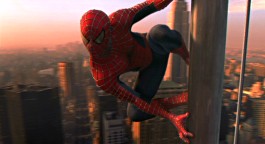 The “Spider-Man Visualizer” area includes a screen-saver as well as a program to affect the “visualizer” element of computer media players. At least, that’s the plan. For reasons unknown, I couldn’t either the screen-saver or the visualizer to work on my computer.
The “Spider-Man Visualizer” area includes a screen-saver as well as a program to affect the “visualizer” element of computer media players. At least, that’s the plan. For reasons unknown, I couldn’t either the screen-saver or the visualizer to work on my computer.
Another fun feature comes from three “exclusive Marvel dot.comics”. We can check out the following adventures: Spider-Man: Blue #1, Black Cat #1, and Peter Parker: Return of the Goblin. I really appreciated the inclusion of these comics. Finally, DVD Two repeats the same weblinks found on the first disc and adds one more for Marvel.com.
While the Spider-Man DVD offers a lot of different features, sometimes more is less. Not many of these components seem terribly memorable and they don’t add a tremendous amount to the package. Most of the pieces appear reasonably interesting, but this set remains somewhat disappointing in the supplements domain, as the DVD doesn’t give us a great look at the creation of the film.
Happily, Spider-Man itself doesn’t disappoint. The movie offers a lively and exciting piece that possesses greater depth and emotion than one might usually expect from this sort of film. It doesn’t seem perfect, but it works tremendously well as a whole and it captures the parts of the comic books that make them so memorable. The DVD provides watchable but somewhat flat picture along with strong audio and an extensive but lackluster collection of extras. While not an exceptional DVD, Spider-Man presents an excellent movie, and the package seems positive enough to warrant my strong recommendation.

